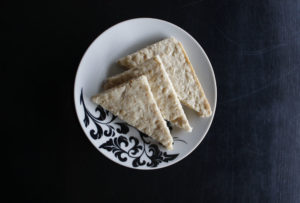As part of our new historical recipe project, our Managing Partner Rob MacDonald brought in his signature Scottish Oatcakes!
He has a personal connection to these delicious treats, and he also delved into the fascinating history of the oatcake below.
[line]
Oats (Avena sativa), a cereal grain which was domesticated in the Fertile Crescent area of the Near East, spread throughout Europe during the Bronze Age. Unique amongst grains, oats contain leguminous protein in levels nearly as high as soya beans, as well as a balanced blend of dietary fiber and other carbohydrates, fats, and essential vitamins and minerals. Its soluble fiber has been shown to lower harmful cholesterol. Tolerant of cool, damp climates, oats became a staple in what is now Scotland prior to the Roman occupation of the British Isles. Requiring very simple processing, such as hand milling in a rotary device called a quern, small cakes made of oats could be easily made with the addition of some water and fat to a mixture of oatmeal. Fourteenth century narratives relate how solders would carry with them a bag of oats and an iron girdle (Scots equivalent of griddle) as their primary source of rations.
The English lexicographer, Dr. Samuel Johnston, who published his famous travel narrative “A Journey to the Western Islands of Scotland” in 1775, described oats as follows in his 1755 dictionary: “A grain, which in England is generally given to horses, but in Scotland supports the people.” Sir Walter Scott reported the following rejoinder by Patrick Murray, 5th Lord Elibank: “Yes, and where else will you see such horses and such men?”
Oatcakes came to Canada with Scottish immigrants in the eighteenth century. Historical cookbooks from Nova Scotia document the transition of oatcakes from a savory staple to a sweet treat by the addition of sugar. Today, both forms are made and enjoyed.
My recipe originated with an elderly Scottish woman who was a resident at the nursing home where my mother-in-law, June Knight, was the head nurse and administrator. I have adapted it to modern dietary sensibilities by substituting canola oil for the bacon fat of the original recipe and eliminating the salt. My cooking technique has also been rendered easier as a nod to the simplicity of traditional methods. I divide the dough into two halves, each of which I roll out on a cookie sheet to make a large rectangle. Once cooked, and while still warm, I cut these into triangles using a pizza wheel, since I don’t own a claymore. I like them best with a little honey.
[line]
MacDonald’s Scottish (Canadian) Oatcakes
3 cups large flake oatmeal
3 cups white flour
½ cup white sugar
1 tsp. baking power
1 cup cooking oil
1 cup cold water
Mix dry ingredients then add oil and combine with a pastry blender. Add water and mix well then form into a large ball. Divide ball in half and roll out each half on a cookie sheet. Bake at 300◦ F for 20 minutes. Cut into quarters, sixteenths, and thirty-seconds (diagonally) to make farls (triangular cakes) using a pizza wheel. Makes 64 oatcakes.










